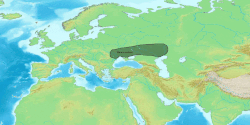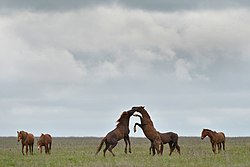Multi-cordoned ware culture
 From Wikipedia - Reading time: 10 min
From Wikipedia - Reading time: 10 min
| Geographical range | Pontic steppe, Eastern Europe |
|---|---|
| Period | Bronze Age |
| Dates | ca. 2200–1750 BC |
| Preceded by | Catacomb culture |
| Followed by | Srubnaya culture, Noua-Sabatinovka-Coslogeni complex |
| Part of a series on |
| Indo-European topics |
|---|
 |
|
|
Multi-cordoned Ware culture or Multiroller ceramics culture, (Russian: Культура многоваликовой керамики, romanized: Kul'tura mnogovalikovoj keramiki (KMK))[1] also known as the Multiple-relief-band ware culture, the Babyno culture or Babino culture or the Mnogovalikovaya kul'tura (MVK), are archaeological names for a Middle Bronze Age culture of Eastern Europe.
Distribution
[edit]From approximately the 22nd to 18th centuries BCE, it occupied an area stretching from the Don to Moldavia, including Dnieper Ukraine, Right-bank Ukraine, and part of the modern Ternopil Oblast, and was bordered by the Volga to the east.
Origins
[edit]KMK succeeded the western Catacomb culture.
Characteristics
[edit]
In 1929, the archaeologist Ya. Brik studied four kurgans of this culture near Ostapye village, currently in Ternopil Raion, Ukraine. He found ceramics, flint tools, bone and bronze decorations. Bottoms, walls and ceilings of the graves are layered with rocks. Skeletons are laid in a contracted position towards the east.
The name of this culture is related to its ceramic goods, such as pots, which were decorated with multiple strips of clay (cordons) before firing. The culture also featured various other distinctive ornaments
KMK tribes practiced herding and made widespread use of chariots.[2] According to Anthony (2007), chariotry spread from the Multi-cordoned ware culture to the Monteoru, Vatin and Ottomány cultures in southeastern Europe.[3]

200 or more Multi-cordoned Ware settlements have been documented, some with cultural deposits 1 metre thick (e.g. Babino III).[1] Occasional fortified settlements are known, pointing to higher interregional conflict than in previous periods. Houses included sunken earth-houses and ground-level wooden-post buildings with a rectangular plan.[6]
Ethnicity
[edit]Circumstantial evidence links KMK to the spread of one or more Indo-European languages. Leo Klejn identifies its bearers with the early Thracians. Other scholars suggest that KMK may have been connected to the Bryges and/or Phrygians.[citation needed]
Successors
[edit]It was increasingly influenced, assimilated and eventually displaced by the Timber grave or Srubna/Srubnaya culture.[7][8][9][10] In c. 2000 – 1800 BCE bearers of KMK migrated southward into the Balkans.
Physical type
[edit]The physical type of the Multi-cordoned Ware culture has been designated as dolichocephalic.[a]
Genetics
[edit]Paternal haplogroups
[edit]According to genetic studies, the Multi-cordoned ware culture had haplogroups R1a and R1b[12][13]
Maternal haplogroups
[edit]Multi-cordoned Ware culture had haplogroups such as J2b1a, J1c2m, H1e, H13a2b2a, H5a1a, R1a1a, V7, U2e2a, H2a2b, U3a, U5a2, R1a, H15a1a1 and HV1[14][15][16][17]
Autosomal DNA
[edit]
See also
[edit]Notes
[edit]References
[edit]- ^ a b Kohl 2007, p. 146.
- ^ Kuzmina 2007, p. 120: "The classification of cheek-pieces and the establishment of their evolution permits us to establish the origin of the disc-shaped cheek-pieces and their chronology. The most archaic disc-shaped cheek-piece was amorphous and undecorated of Type I and derived from contexts of the Catacomb-Multi-roller Ware and Abashevo cultures from the Ukraine to the Urals. This permits us to attribute the first controlling of chariots with cheek-pieces to tribes of the Abashevo and Multi-roller Ware cultures (KMK=Kul'tura Mnogovalikovoy Keramiki)"
- ^ Anthony, David (2007). The Horse, the Wheel, and Language. Princeton University Press. p. 411. ISBN 978-0-691-14818-2.
Chariotry spread west through the Ukrainian steppe MVK [Mnogovalikovaya] culture into southeastern Europe's Monteoru (phase Icl-Ib), Vatin, and Otomani cultures
- ^ Librado, Pablo (2021). "The origins and spread of domestic horses from the Western Eurasian steppes". Nature. 598 (7882): 634–640. Bibcode:2021Natur.598..634L. doi:10.1038/s41586-021-04018-9. PMC 8550961. PMID 34671162.
- ^ "The world's first horse riders found near the Black Sea". phys.org. March 2023.
- ^ "VIII.19.1. Multi-Cordoned Ware". Indo-Europeans and Uralic peoples.
- ^ Валиковой керамики культура // БРЭ. Т.4. М.,2006.
- ^ Киммерийский период // БРЭ. Т.13. М.,2008.
- ^ Киммерийцы // БРЭ. Т.13. М.,2008.
- ^ Евразийская степная металлургическая провинция // БРЭ. Т.9. М.,2007.
- ^ Kuzmina 2007, p. 384.
- ^ Lazaridis, Iosif; Alpaslan-Roodenberg, Songül; Acar, Ayşe; Açıkkol, Ayşen; Agelarakis, Anagnostis; Aghikyan, Levon; Akyüz, Uğur; Andreeva, Desislava; Andrijašević, Gojko; Antonović, Dragana; Armit, Ian; Atmaca, Alper; Avetisyan, Pavel; Aytek, Ahmet İhsan; Bacvarov, Krum (2022). "The genetic history of the Southern Arc: A bridge between West Asia and Europe". Science. 377 (6609): eabm4247. doi:10.1126/science.abm4247. ISSN 0036-8075. PMC 10064553. PMID 36007055. S2CID 251843620.
- ^ Nikitin, Alexey; Ivanova, Svetlana (18 April 2024). "Long-distance exchanges along the Black Sea coast in the Eneolithic and the steppe genetic ancestry problem". bioRxiv.
- ^ Juras, Anna; Chyleński, Maciej; Ehler, Edvard; Malmström, Helena; Żurkiewicz, Danuta; Włodarczak, Piotr; Wilk, Stanisław; Peška, Jaroslav; Fojtík, Pavel; Králík, Miroslav; Libera, Jerzy; Bagińska, Jolanta; Tunia, Krzysztof; Klochko, Viktor I.; Dabert, Miroslawa; Jakobsson, Mattias; Kośko, Aleksander (2 Aug 2018), "Mitochondrial genomes reveal an east to west cline of steppe ancestry in Corded Ware populations", Nature, 8 (11603)
- ^ Nikitn, Alexey G.; Ivanova, Svetlana; Kiosak, Dmytro; Badgerow, Jessica; Pashnick, Jeff (2 Feb 2017), "Subdivisions of haplogroups U and C encompass mitochondrial DNA lineages of Eneolithic–Early Bronze Age Kurgan populations of western North Pontic steppe", Nature, 62: 605-613
- ^ Lazaridis, Iosif; Alpaslan-Roodenberg, Songül; Acar, Ayşe; Açıkkol, Ayşen; Agelarakis, Anagnostis; Aghikyan, Levon; Akyüz, Uğur; Andreeva, Desislava; Andrijašević, Gojko; Antonović, Dragana; Armit, Ian; Atmaca, Alper; Avetisyan, Pavel; Aytek, Ahmet İhsan; Bacvarov, Krum (2022). "The genetic history of the Southern Arc: A bridge between West Asia and Europe". Science. 377 (6609): eabm4247. doi:10.1126/science.abm4247. ISSN 0036-8075. PMC 10064553. PMID 36007055. S2CID 251843620.
- ^ Nikitin, Alexey; Ivanova, Svetlana (18 April 2024). "Long-distance exchanges along the Black Sea coast in the Eneolithic and the steppe genetic ancestry problem". bioRxiv.
- ^ Nikitin, Alexey; Ivanova, Svetlana (18 April 2024). "Long-distance exchanges along the Black Sea coast in the Eneolithic and the steppe genetic ancestry problem". bioRxiv.
Sources
[edit]- Kohl, Philip L. (2007). The Making of Bronze Age Eurasia. Cambridge University Press. ISBN 978-1-1394-6199-3.
- Kuzmina, Elena E. (2007). Mallory, J. P. (ed.). The Origin of the Indo-Iranians. BRILL. ISBN 978-9004160545.
Literature
[edit]- Куштан Д.П. Памятники Культуры Многоваликовой Керамики В Среднем Поднепровье (По Материалам Разведок В Зоне Кременчугского Водохранилища) Archived 2013-04-16 at archive.today
- Тернопільський енциклопедичний словник. — Тернопіль, видавничо-поліграфічний комбінат «Збруч», том 1, 2004.
- Тернопілля: сторінки історії. — X, 1995;
- Словник-довідник з археології. — К., 1996.
 KSF
KSF